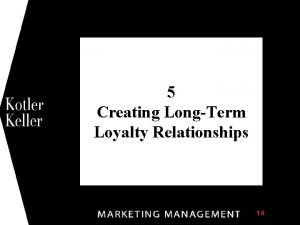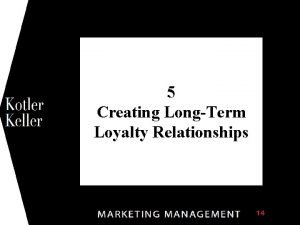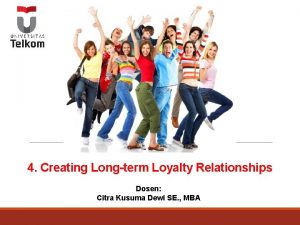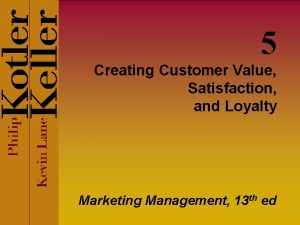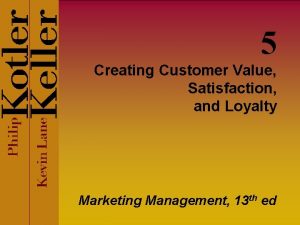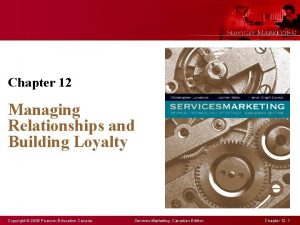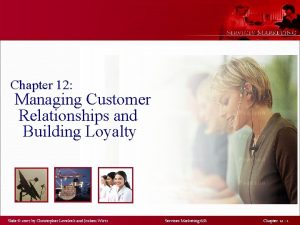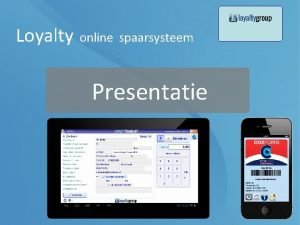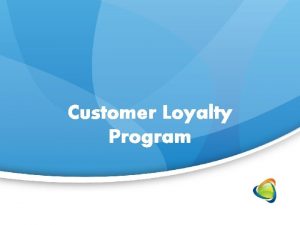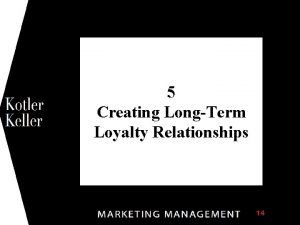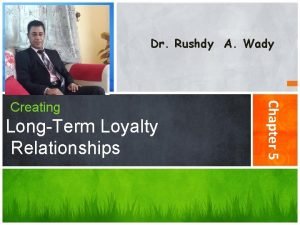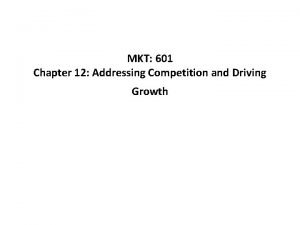MKT 601 Chapter 03 Creating Longterm Loyalty Relationships










- Slides: 10

MKT: 601 Chapter 03: Creating Long-term Loyalty Relationships MKT 601, CH-03, MNH 1

Building Customer Value, Satisfaction, and Loyalty Customer Perceived Value Defining Value/ total Customer Benefit and Total Customer Cost Applying Value concept Steps for Customer value Analysis • 1. Identify the major attributes and benefits customers’ value • 2. Assess the quantitative importance of the different attributes and benefits. • 3. Assess the company’s and competitors’ performances on the different customer values against their rated importance. • 4. Examine how customers in a specific segment rate the company’s performance against a specific major competitor on an individual attribute or benefit basis. If the company’s offer exceeds the competitor’s offer on all important attributes and benefits, the company can charge a higher price (thereby earning higher profits), or it can charge the same price and gain more market share. • 5. Monitor customer values over time. MKT 601, CH-03, MNH 2

Delivering High Customer Value Loyalty • Value proposition (all the benefits that company promised) • Value delivery system (experience of customers for obtaining the product) Total Customer satisfaction Monitoring satisfaction Measurement techniques: • Periodic survey • Customer loss rate • Mystery shoppers MKT 601, CH-03, MNH 3

• Influence of Customer Satisfaction • Product and Service quality • Quality is the totality of features and characteristics of a product or service that bear on its ability to satisfy stated or implied needs. • Impact of Quality • Maximizing customer Lifetime value • Customer Profitability Analysis/Activity Based Costing MKT 601, CH-03, MNH 4

MKT 601, CH-03, MNH 5

Measuring Customer Lifetime Value Attracting and retaining Customers Reducing defection • Define and measure its retention rate • Distinguishes the causes of customer attrition and identify those can be managed better • Compare the lost profit equal to the customer’s lifetime value from a lost customer to the cost to reduce the defection rate The Marketing Funnels MKT 601, CH-03, MNH 6

• Acquiring new customers can cost five times more than satisfying and retaining current ones. It requires a great deal of effort to induce satisfied customers to switch from their current suppliers. • The average company loses 10 percent of its customers each year. • A 5 percent reduction in the customer defection rate can increase profits by 25 percent to 85 percent, depending on the industry. • Profit rate tends to increase over the life of the retained customer due to increased purchases, referrals, price premiums, and reduced operating costs to service. MKT 601, CH-03, MNH 7

MANAGING THE CUSTOMER BASE • Reducing the rate of customer defection • Increasing the longevity of the customer relationship. • Enhancing the growth potential of each customer through “share of wallet, ” crossselling, and up-selling • Making low-profit customers more profitable or terminating them • Focusing disproportionate effort on high-profit customers • Building loyalty INTERACTING WITH CUSTOMERS Forming Strong Customer Bonds • Create superior products, services, and experiences for the target market. • Get cross-departmental participation in planning and managing the customer satisfaction and retention process. • Integrate the “Voice of the Customer” to capture their stated and unstated needs or requirements in all business decisions. • Organize and make accessible a database of information on individual customer needs, preferences, contacts, purchase frequency, and satisfaction. • Make it easy for customers to reach appropriate company staff and express their needs, perceptions, and complaints. • Assess the potential of frequency programs and club marketing programs. • Run award programs recognizing outstanding MKT 601, CH-03, MNHemployees. 8

Develop loyalty programs • Frequency programs (FPs) • Club membership program Create Institutional Ties Brand Communities Types of Brand Communities Maximizing the Benefits of Brand Communities Maximizing online brand communities effectiveness • Enhance the timeliness of information exchanged • Enhance the relevance of information posted • Extend the conversation • Increase the frequency of information exchanged Win Backs Cultivating Customer Relationships Customer Relationship Management Personalizing marketing Customer Empowerment Customer Reviews and Recommendations Customer Complaints MKT 601, CH-03, MNH 9

Recovering Customer goodwill • Hotline number • Contact complaining customer ASAP • Accept responsibility for the customer’s disappointment: don’t blame • Use empathic people • Resolve the complaint swiftly MKT 601, CH-03, MNH 10
 Questions about loyalty in relationships
Questions about loyalty in relationships Creating long term loyalty relationships
Creating long term loyalty relationships Creating long term loyalty relationship
Creating long term loyalty relationship Creating customer value satisfaction and loyalty
Creating customer value satisfaction and loyalty Creating customer value satisfaction and loyalty
Creating customer value satisfaction and loyalty Creating customer value satisfaction and loyalty
Creating customer value satisfaction and loyalty Linux kernel longterm
Linux kernel longterm Thomas silverstein
Thomas silverstein Wheel of loyalty
Wheel of loyalty Managing customer relationships and building loyalty
Managing customer relationships and building loyalty Loyal agent argument
Loyal agent argument
